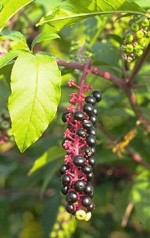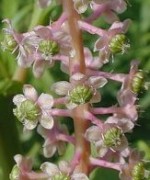 Pokeweed is a perennial weed native to eastern United States, the Midwest, and the Gulf Coast but has spread to the west coast, avoiding the Mountain states. It prefers part sun, and rich, loamy, moist soil but tolerates less and is common in disturbed sites such as gardens, roadsides, pastures, fencerows, barnyards, and woodland borders. Pokeweed is toxic to humans and livestock but the berries are eaten by song birds such as gray catbird, northern mockingbird, and northern cardinal.
Pokeweed is a perennial weed native to eastern United States, the Midwest, and the Gulf Coast but has spread to the west coast, avoiding the Mountain states. It prefers part sun, and rich, loamy, moist soil but tolerates less and is common in disturbed sites such as gardens, roadsides, pastures, fencerows, barnyards, and woodland borders. Pokeweed is toxic to humans and livestock but the berries are eaten by song birds such as gray catbird, northern mockingbird, and northern cardinal.

 Description: Plants die down in the winter but emerge in the spring and grow up to 10 feet tall in ideal sites. The erect, smooth, hairless stem branches regularly and may be green to purplish red becoming smaller in size as they ascend. The leaves are up to 12″ long, give off an unpleasant odor when crushed, and have smooth margins and conspicuous pink veins on their lower surface. Clusters of flowers are produced in upright or drooping racemes from early summer to early fall. The flowers lack petals but have four white to pink sepals that look like petals. The flowers give way to juicy green berries that turn white, then purple, as they ripen and contain 10 black shiny, lens-shaped seeds that can persist in the soil for 40 years. Birds that eat the berries are significant in the spread of the weed. The root system consists of a fleshy taproot that can resprout when the plant is cut down.
Description: Plants die down in the winter but emerge in the spring and grow up to 10 feet tall in ideal sites. The erect, smooth, hairless stem branches regularly and may be green to purplish red becoming smaller in size as they ascend. The leaves are up to 12″ long, give off an unpleasant odor when crushed, and have smooth margins and conspicuous pink veins on their lower surface. Clusters of flowers are produced in upright or drooping racemes from early summer to early fall. The flowers lack petals but have four white to pink sepals that look like petals. The flowers give way to juicy green berries that turn white, then purple, as they ripen and contain 10 black shiny, lens-shaped seeds that can persist in the soil for 40 years. Birds that eat the berries are significant in the spread of the weed. The root system consists of a fleshy taproot that can resprout when the plant is cut down.

 Control: Getting rid of pokeweed can be difficult. Young plants can be easily pulled up but mature ones develop deep tap roots and are difficult to dig up. Cutting the plant below the soil line may be effective but the roots often resprout. Mechanical methods of control such as plowing is the best way to control large infestation. Herbicides such as glyphosate and dicambra are not always effective and require more than one application.
Control: Getting rid of pokeweed can be difficult. Young plants can be easily pulled up but mature ones develop deep tap roots and are difficult to dig up. Cutting the plant below the soil line may be effective but the roots often resprout. Mechanical methods of control such as plowing is the best way to control large infestation. Herbicides such as glyphosate and dicambra are not always effective and require more than one application.